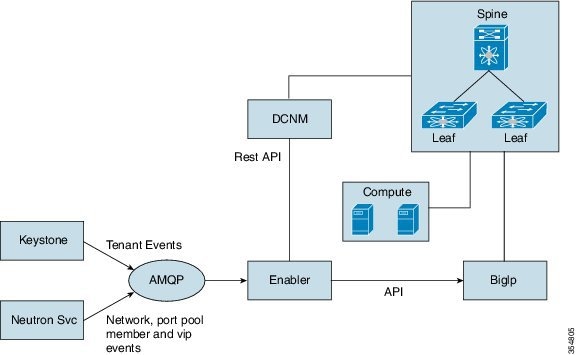OpenStack supports
FWaaS (Firewall-as-a-Service) that allows users to add perimeter firewall
management to networking. FWaaS supports one firewall policy and logical
firewall instance per project/tenant. With Cisco Programmable Fabric, each
compute node is attached to a leaf node, which hosts the physical default
gateways for all the VMs on the compute node.
A VM based Firewall
such as CSR1000v can be inserted into the Cisco Programmable Fabric
architecture and used as FWaaS in OpenStack. FWaaS insertion into the fabric
will be automatically triggered via OpenStack FWaaS functionality, including
configuring the firewall rules and policy. The leaf switch will be configured
using its auto-configuration feature and VRF and network templates from DCNM
for both its internal VRF/network and external VRF/network for a given tenant.
While the initial
effort is based on a Cisco Adaptive Security Appliance (ASA) firewall, the same
architecture can allow the insertion of VM based firewall device into the
fabric as well. Since the firewall is actually acting as a router, OSPF will be
transparently programed by the enabler when FWaaS is provisioned from
OpenStack.

Note |
Only physical ASA
will be supported in first release. CSR1000v (virtual firewall) is not
supported.
|
FWaaS
Integration
OpenStack FWaaS
adds perimeter firewall management to Networking. In OpenStack, routing is
achieved through a router plugin. The router plugin uses the underlying Linux
kernel routing implementation, to achieve routing. Every router created in
OpenStack, has a Linux namespace created for it. If a VM in a subnet wants to
communicate with another subnet, those subnets are added as interfaces to the
router. In Juno release, every project is limited to one Firewall. The Firewall
can have a policy, which can have multiple rules. The rules specify the
classifier and actions. The firewall rules are applied to all the routers in
the project and further to all the interfaces of a router.

OpenStack
Firewall with Nexus Fabric
You can have
firewall modules from different implementations with Nexus Fabric. When
OpenStack is integrated with the Nexus Fabric, it is generally used as a tenant
edge firewall. The following needs to be supported:
The following
section describes the packet flow for a tenant when a perimeter firewall is
added through OpenStack in the presence of Physical ASA device acting as the
firewall.
Firewall
Manager
Firewall manager
is responsible for acting on firewall related events from OpenStack such as
policies, rules and Firewall creation/deletion and modification. The firewall
and its associated rules and policies are decoded and stored per tenant. Based
on the configuration, this module dynamically loads the Firewall Driver module.
This module calls the Firewall Driver module when a firewall configuration gets
added/deleted or modified.
For creating a
Firewall, you need to create the rules, policy containing the rules and a
Firewall containing the policy. You can create this in any order. For example,
a Firewall can be created without any policy attached and later on, policies
can be attached to the Firewall. Similarly, policies can be created without any
rules attached at the beginning and then the policies can be updated with the
rules. So, the Firewall module is responsible for caching the information and
calling the modules to prepare the fabric or configure the Firewall device only
after the complete firewall information is obtained.
Firewall
Module
Firewall module
is responsible for interacting with the actual device and doing the
configuration. Depending on the appliance, the driver may use REST API or CLIs.
Cisco Physical ASA and OpenStack Native firewall are supported.
Firewall module
is responsible for the following:
-
Set-up the
fabric when a firewall is created.
-
Clear the
fabric configuration when the firewall is deleted.
-
Provide APIs
on information about the fabric for other modules including the driver to use.




 Feedback
Feedback